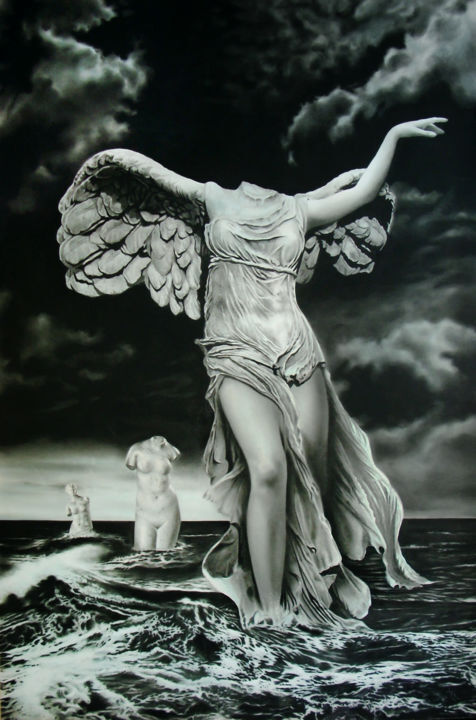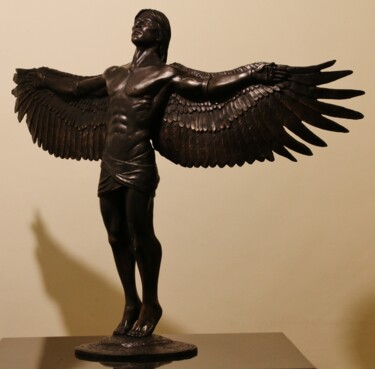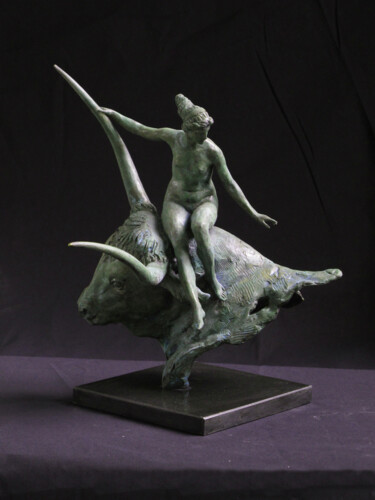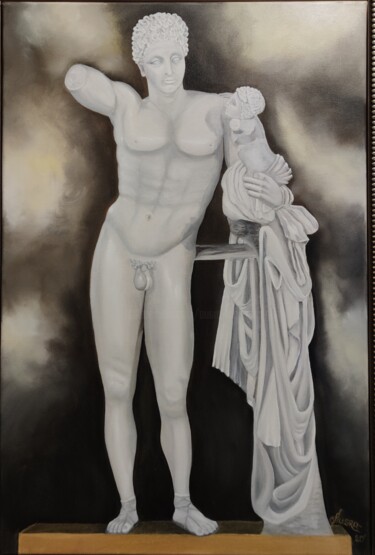 Karin Aznavour, Astronaut Greek god, 2020. Digital art, several formats available.
Karin Aznavour, Astronaut Greek god, 2020. Digital art, several formats available.
The importance of ancient Greek sculpture
The sculpture of ancient Greece represents an essential reference point for the study of the realistic rendering of the human body, in fact, it has indelibly marked the history of Western art in its most varied currents and manifestations, which have extended from modern times to contemporary ones. But what are the origins of this art form that has changed the world?
 Yaroslav Kurbanov, War of the world, 2016. Oil / acrylic / tempera on canvas, 100 x 80 cm.
Yaroslav Kurbanov, War of the world, 2016. Oil / acrylic / tempera on canvas, 100 x 80 cm.
 Secam, V.nus - antik gaming, 2019. Acrylic / spray paint / marker / stencil / plastic on canvas, 116 x 73 cm.
Secam, V.nus - antik gaming, 2019. Acrylic / spray paint / marker / stencil / plastic on canvas, 116 x 73 cm.
Short history of the sculpture of ancient Greece
The earliest manifestations of ancient Greek sculpture, found between 800 and 300 B.C., have clear references to Egyptian and Near Eastern monumental art, which, only later, developed into a uniquely Greek aesthetic vision. In fact, in the Greece of the 8th century B.C., the production of small solid figures in clay, ivory, bronze and wood was very widespread, even if few examples of the latter material have survived due to its susceptibility to erosion. The subjects depicted with these supports were often figures of men and animals, human heads and griffins, which were used as attachments to bronze vessels or as votive offerings destined for sanctuaries. As for the style, the above-mentioned human figures present a strong affinity with contemporary geometric ceramics, since they are characterized by elongated limbs and triangular torsos. As for the oldest sculptures made of limestone, they date back to the middle of the 7th century B.C., a period in which more complex bronze works, depicting warriors, charioteers and musicians, began to become more common. Marble sculptures, on the other hand, spread from the sixth century BC, through the production of monumental or life-size statues, destined to be both offerings for sanctuaries and grave markers. Returning to the sculptures made of stone, the most popular and large specimens, dating from the seventh century BC, are known by the name of Kouroi, when they immortalize young males, or Kore, in the case in which they represent female figures dressed. These characters, marked by a strong rigidity, similar to that of the Egyptian monumental statues, are characterized by arms held straight at the sides of the body, advanced foot, fixed gaze and a facial morphology expressionless. This staticism faded with time, in particular thanks to the introduction of details full of "life", the result of the resourcefulness of Greek sculptors, who moved away from the rigid rules of archaic conceptual art, in order to begin to reproduce what they actually observed from life. The search for such realism exploded with force during the classical period, when artists began to create life-size marble sculptures, with the aim of glorifying the human form, and especially the male form. From this moment on, the figures, made with an unprecedented sensuality, were frozen in the state of action, just as if only a second before they had actually been alive. The innovative study of the bodies is also combined with a new approach to the depiction of faces and clothes, in fact, the former acquired greater expressiveness, becoming a reminder of a particular state of mind, while the latter were sculpted in a more realistic and subtle, being able to reveal the contours of the bodies. In short, these sculptures succeeded in transforming hard, lifeless matter into intangible qualities such as poise, mood and grace, which gave rise to some of the greatest masterpieces of world art.
 Egidio Gariano, Apollo MMXXI, 2021. Acrylic on canvas, 100 x 100 cm.
Egidio Gariano, Apollo MMXXI, 2021. Acrylic on canvas, 100 x 100 cm.
 Marko Grgat, Fragment 8, 2020. Earthenware sculpture on wood, 31 x 17 x 14 cm / 2.00 kg.
Marko Grgat, Fragment 8, 2020. Earthenware sculpture on wood, 31 x 17 x 14 cm / 2.00 kg.
Greek Sculpture in Contemporary Art
Ancient Greek sculpture, with its elegance, refinement and sophistication of execution, continues to inspire artists all over the world, including those of Artmajeur, who have provided us with a contemporary interpretation of iconic works and subjects, capable of "resurrecting" Greek archaism and classicism in new atmospheres, derived from Abstractionism, Surrealism and Pop-Street art. This is well exemplified by Kouros by Antoni Dragan, Nike liberated by Marco Tidu and Zeus Pop by Vincent Bardou.
 Antoni Dragan, Kouros, 2022. Stone sculpture, 35 x 10 x 10 cm / 2.00 kg.
Antoni Dragan, Kouros, 2022. Stone sculpture, 35 x 10 x 10 cm / 2.00 kg.
Antoni Dragan: Kouros
The sculpture by Artmajeur's artist, Antoni Dragan, reproposes an archaic Greek Kouros while respecting its formal peculiarities. In fact, the young nude, made of stone, is immortalized in his standardized pose, marked by hands at the sides of the body and a forward leg. It is important to emphasize that in the Greek context this lack of adherence to the canons of realism was linked both to a "superficial" observation of reality and to the need to represent first and foremost the concept of youth of which the Kouros was a symbol. In Dragan's work a new symbolism is added to this tradition, which, conferred by an innovative red and black color casting, places the work in a new context halfway between archaism and contemporaneity. In fact, the technique with which the artist places the paint on the support follows that of Pollock's dripping, an undisputed master of the history of twentieth-century art.
 Vincent Bardou, Zeus Pop, 2022. Acrylic / spray paint / ink / marker / pigments on canvas, 100 x 80 cm.
Vincent Bardou, Zeus Pop, 2022. Acrylic / spray paint / ink / marker / pigments on canvas, 100 x 80 cm.
Vincent Bardou: Zeus Pop
Zeus, supreme divinity of the Greek religion, was the subject of many representations in the ancient world, among which, the most iconic is surely the one of Olympia (Greece), unfortunately now lost. The statue of the city of the Games, made by the famous Phidias and placed inside the Temple of Zeus, was actually considered one of the seven wonders of the world. In fact, the work stood out, both for its height, almost 12 meters, and for its preciousness, being plated in gold and ivory and enriched by details in cedar adorned with ebony, ivory, gold and precious stones. Unfortunately, the temple that contained this masterpiece was destroyed in 426 AD, so that only its legendary fame remains of the statue. However, the myth of Zeus' iconography continues to live on, in a surprising way, even in contemporary art, as evidenced by the dynamic and colorful painting by Artmajeur artist Vincent Bardou. In fact, this work, halfway between the chromatic vivacity of Pop art and the tags and graffiti of Street art, celebrates the god in a profane and completely new way, almost as if he had become a popular Hollywood star.
 Marco Tidu, Nike liberated, 2016. Charcoal on cardboard, 136 x 96 cm.
Marco Tidu, Nike liberated, 2016. Charcoal on cardboard, 136 x 96 cm.
Marco Tidu: Nike liberata
The surreal hyper-realism of the charcoal realized by Marco Tidu highlights, in an impossible context, the perfection of the Greek stylistic elements, which are celebrated through new and innovative remakes, among which those of the Winged Victory of Samothrace and the Venus of Milo clearly stand out. In fact, as suggested by the title, it seems that the Winged Victory, protagonist of the work, has managed, unlike the other two static "women", to "free herself" from her immobility, obtaining the dynamism of a living being. What has been said was certainly made possible by the realism of Pythocritus' masterpiece, since only a statue, which already in itself seems real, could really become such. Therefore, with this tale of freedom, Tidu's work, besides showing the beauty of classicism, also invites us to daydream.


 Olimpia Gaia Martinelli
Olimpia Gaia Martinelli























